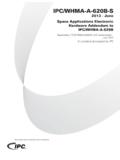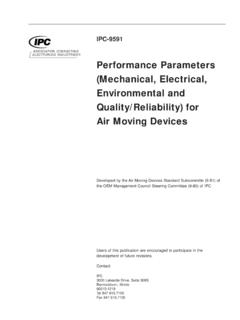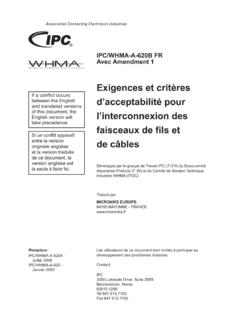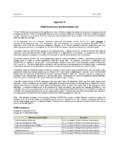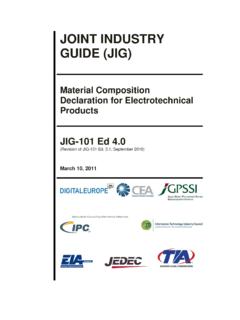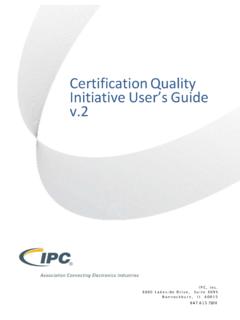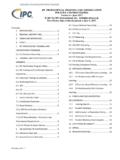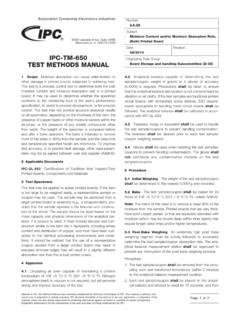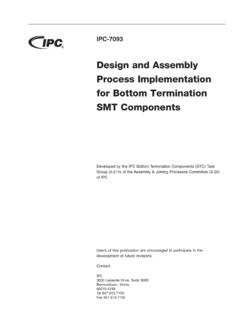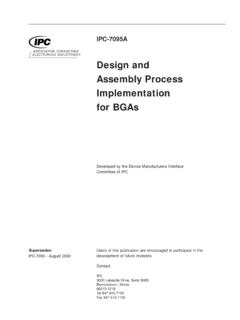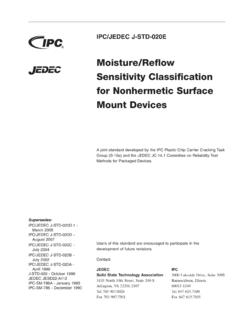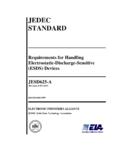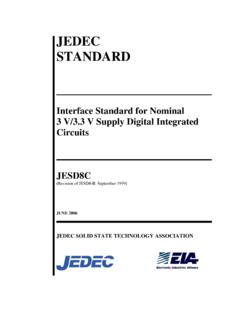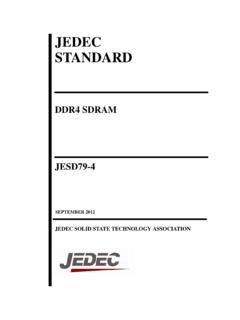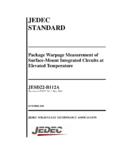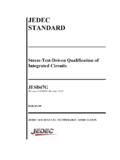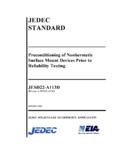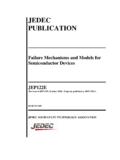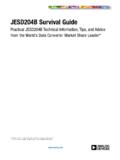Transcription of ASSOCIATION CONNECTING ELECTRONICS …
1 IPC/ jedec J-STD-020 CMoisture/ReflowSensitivity Classificationfor NonhermeticSolid State SurfaceMount DevicesA joint standard developed by the IPC Plastic Chip Carrier Cracking TaskGroup (B-10a) and the jedec Committee on Reliability TestMethods for Packaged DevicesUsers of this standard are encouraged to participate in thedevelopment of future :JEDECS olid State Technology Association2500 Wilson BoulevardArlington, VA 22201-3834 Phone (703) 907-7500 Fax (703) 907-7501 IPC2215 Sanders RoadNorthbrook, IL 60062-6135 Phone (847) 509-9700 Fax (847) 509-9798 Supersedes:IPC/ jedec J-STD-020B -July 2002 IPC/ jedec J-STD-020A -April 1999J-STD-020 - October 1996 jedec JESD22-A112 IPC-SM-786A - January 1995 IPC-SM-786 - December 1990 ASSOCIATION CONNECTINGELECTRONICS INDUSTRIES Table of .. 12 APPLICABLE Solid State Technology Associaton.
2 Industry standards .. Humidity Chambers .. Reflow Equipment .. Convection (Preferred) .. Microscope .. Acoustic Microscope .. Test .. Apparatus (Optional) .. 24 with Pb-Free Rework .. Requirements .. (Qualified Package WithoutAdditional Reliability Testing) .. and Rework .. Electrical Test .. Inspection .. Soak .. External Visual .. Electrical Test .. Acoustic Microscopy .. Criteria .. Requiring Further Evaluation .. Verification .. 87 MOISTURE/REFLOW 88 OPTIONAL WEIGHT GAIN/LOSS Gain .. Curve .. Points .. Weight .. Soak .. Curve .. Points .. 99 ADDITIONS AND 9 Annex 10 FiguresFigure 5-1 classification Reflow Profile .. 6 TablesTable 4-1 SnPb Eutectic Process Package PeakReflow Temperatures .. 3 Table 4-2Pb-free Process Package ClassificationReflow Temperatures.
3 3 Table 5-1 Moisture sensitivity Levels .. 5 Table 5-2 classification Reflow Profiles .. 6 July 2004 IPC/ jedec J-STD-020 CvMoisture/Reflow sensitivity classification forNonhermetic Solid State Surface Mount Devices1 PURPOSEThe purpose of this standard is to identify the classification level of nonhermetic solid state surface mount devices (SMDs)that are sensitive to moisture-induced stress so that they can be properly packaged, stored, and handled to avoid damageduring assembly solder reflow attachment and/or repair standard may be used to determine what classification /preconditioning level should be used for SMD package qualifi-cation. Passing the criteria in this test method is not sufficient by itself to provide assurance of long-term ScopeThis classification procedure applies to all nonhermetic solid state Surface Mount Devices (SMDs) in packages,which, because of absorbed moisture, could be sensitive to damage during solder reflow.
4 The term SMD as used in thisdocument means plastic encapsulated surface mount packages and other packages made with moisture-permeable categories are intended to be used by SMD producers to inform users (board assembly operations) of the level of mois-ture sensitivity of their product devices, and by board assembly operations to ensure that proper handling precautions areapplied to moisture/reflow sensitive devices. If no major changes have been made to a previously qualified SMD package,this method may be used for reclassification according to standard cannot address all of the possible component, board assembly and product design combinations. However, thestandard does provide a test method and criteria for commonly used technologies. Where uncommon or specialized compo-nents or technologies are necessary, the development should include customer/manufacturer involvement and the criteriashould include an agreed definition of product packages classified to a given moisture sensitivity level by using Procedures or Criteria defined within any previousversion of J-STD-020, JESD22-A112 (rescinded), IPC-SM-786 (superseded) do not need to be reclassified to the currentrevision unless a change in classification level or a higher peak reflow temperature is.
5 If the procedures in this document are used on packaged devices that are not included in this specification s scope,the failure criteria for such packages must be agreed upon by the device supplier and their end BackgroundThe vapor pressure of moisture inside a nonhermetic package increases greatly when the package isexposed to the high temperature of solder reflow. Under certain conditions, this pressure can cause internal delamination ofthe packaging materials from the die and/or leadframe/substrate, internal cracks that do not extend to the outside of thepackage, bond damage, wire necking, bond lifting, die lifting, thin film cracking, or cratering beneath the bonds. In the mostsevere case, the stress can result in external package cracks. This is commonly referred to as the popcorn phenomenonbecause the internal stress causes the package to bulge and then crack with an audible pop.
6 SMDs are more susceptibleto this problem than through-hole parts because they are exposed to higher temperatures during reflow soldering. The rea-son for this is that the soldering operation must occur on the same side of the board as the SMD device. For through-holedevices, the soldering operation occurs under the board that shields the devices from the hot APPLICABLE jedec Solid State Technology AssociatIon1 JESD22-A120 Test Method for the Measurement of Moisture Diffusivity and Water Solubility in Organic Materials Used inIntegrated CircuitsJESD22-A113 Preconditioning Procedures of Plastic Surface Mount Devices Prior to Reliability TestingJESD 47 Stress Test Driven Qualification SpecificationJESD-625 Requirements for Handling Electrostatic Discharge Sensitive (ESD) Devices1. 2004 IPC/ jedec J-STD-020C1
